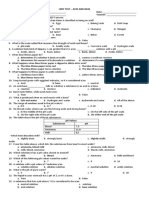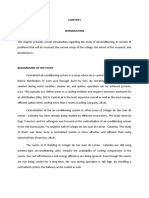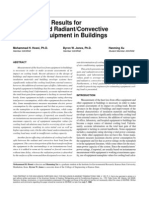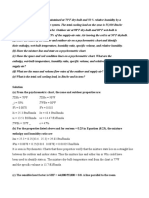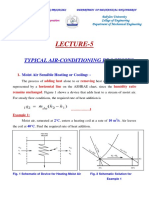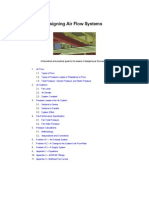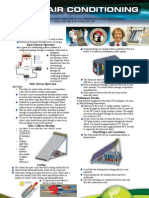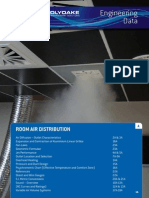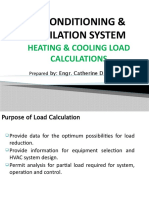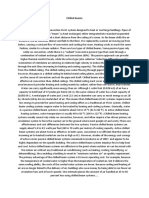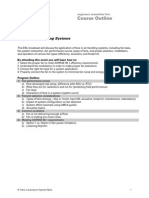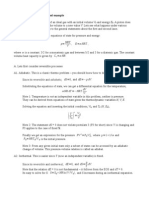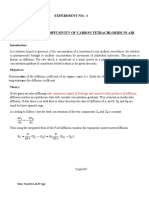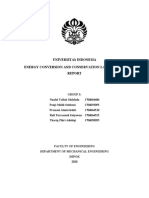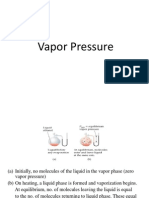Psychrometrics History. ASHRAE Journal Oct-2004
Psychrometrics History. ASHRAE Journal Oct-2004
Uploaded by
alvarellos92Copyright:
Available Formats
Psychrometrics History. ASHRAE Journal Oct-2004
Psychrometrics History. ASHRAE Journal Oct-2004
Uploaded by
alvarellos92Copyright
Available Formats
Share this document
Did you find this document useful?
Is this content inappropriate?
Copyright:
Available Formats
Psychrometrics History. ASHRAE Journal Oct-2004
Psychrometrics History. ASHRAE Journal Oct-2004
Uploaded by
alvarellos92Copyright:
Available Formats
The following article was published in ASHRAE Journal, November 2004.
Copyright 2004 American Society of Heating, Refrigerating
and Air-Conditioning Engineers, Inc. It is presented for educational purposes only. This article may not be copied and/or distributed electroni-
cally or in paper form without permission of ASHRAE.
Psychrometric
Chart Celebrates
Ph
oto
:Da
vid
A.
Bu
rba
,P
h.D
100 Anniversary
.
th
Hygrodeik wet and dry-bulb hygrometer.
Vanderbilt University Garland Collection.
By Donald P. Gatley, P.E., Fellow/Life Member ASHRAE
A Simple Tool
W
hat is psychrometrics? One Web site calls it the dreaded P- At first glance a psychrometric
chart appears ominous with its
word! Psychrometrics is a subscience of physics dealing with myriad of tiny lines crisscrossing in
the properties and processes of moist air. Moist air is dened as a every direction. Actually, once un-
derstood, this apparent complexity
mixture of two gases: dry air and water vapor (the gas phase of H2O).1 is readily dismissed and the psych
Some broaden the denition of psychrometrics to cover mixtures of chart can become a relatively simple
and invaluable design tool. (Circa
the gas of one substance (any dry gas component) and the condens- 1950) Julian R. Fellows, emeritus
professor of mechanical engineering,
able vapor of a second substance. Psychrometrics is not conned to University of Illinois.
the world of air conditioning. It is used in the elds of agricultural and
aeronautical engineering, food engineering, drying of crops, grains, air-conditioning designers may have dif-
and pharmaceuticals, dehydration, dehumidication, humidication, culty visualizing the tasks of the designer
in pre-1960 when handheld calculators and
moisture control, meteorology, and weather reporting. PCs did not exist. Most calculations were
performed manually or with a slide rule,
This article looks at the state-of-the izing the changes of properties in a se- or perish the thought, with a table of loga-
art of psychrometrics prior to 1904 when quence of psychrometric processes; e.g., rithms. Some engineers were lucky when
Willis H. Carrier produced the rst chart (a) as the outside and return air mixes, a group of 10 shared a noisy Frieden
and then traces the developments from (b) proceeds through heating and cooling calculator. Designing systems and solving
1904 to 2004. coils, (c) the supply fan, (d) supply duct, problems using the psych chart was a
and on to (e) the conditioned space. time-saving blessingnot a chore.
The Psychrometric Chart Prior to the advent of personal computer By 1990 approximately 75% of prac-
So what is a psychrometric chart and psychrometric software, the psychro- titioners used the psychrometric chart
why would anyone want to use it? The metric chart also was used extensively About the Author
psychrometric chart is a convenient and as an extremely useful graphical tool for Donald P. Gatley, P.E., is a consulting engineer and
useful tool for (1) determining moist air solving and diagnosing and then visual- moisture consultant. He is the author of ASHRAEs
psychrometric properties, and (2) visual- izing psychrometric processes. Younger Understanding Psychrometrics.
16 ASHRAE Journal ashrae.org November 2004
Measurable Psychrometric Properties Calculable Psychrometric Properties
Description Symbol SI Unit I-P Unit Description Symbol SI Unit I-P Unit
Dry-Bulb Temp. tDB C F Specic Enthalpy h kJ/kgDA Btu/lbDA
Wet-Bulb Temp. tWB C F
Specic Volume v m3/kgDA ft3/lbDA
Dew-Point Temp. tDP C F
Humidity Ratio w kgwv /kgDA lbwv /lbDA
Relative Humidity RH % %
PBAR Water Vapor Pressure pwv Pa in. HG or psia
Barometric Pressure Pa in. HG or psia
Table 1: Nine of the most common psychrometric properties.
James Apjohn J.F. Daniell Charles LeRoy
Ludwig Achim von Arnim Francesco Eschinardi John Leslie
Richard Assman James Pollard Espy Charles F. Marvin
Ernest Ferdinand August Gabriel Daniel Fahrenheit Edme Mariotte
Amedeo Avogadro William Ferrel Sir Isaac Newton
Carl Wilhelm Bckman Jr. Joseph Louis Gay-Lussac Blaise Pascal
Robert Boyle James Glaisher Joseph Priestly
Auguste Bravais James Hutton Henri Victor Regnault
Anders Celsius James Ivory Horace Bndict de Saussure
Jacques Alexander Csar Charles Julius Juhlin C.W. Scheele
John Dalton Antoine Laurent de Lavoisier Evanglista Torricelli
Table 2: Partial listing of psychrometric pioneers prior to 1900.
as a tool in solving psychrometric problems and the rest used pressure; barometric pressure; stationary wet-bulb, dry-bulb, and
computer software. In the rst decade of the 21st century most dew-point temperature; relative humidity, water-vapor density (in
practitioners rely on psychrometric software based on ideal-gas grains and pounds per cubic foot), and the additional quantity
algorithms (with 99% or greater accuracy). As a secondary of H2O required for complete saturation. Part of Glaishers data
function most software programs generate a psychrometric chart was empirical and based on two years of observations of these
showing the state points and the psychrometric process lines properties at Greenwich, England. Glaisher may not have been
connecting the state points. The displayed state point properties aware that stationary wet-bulb temperature varied widely because
either will be original data entries or the results of accurate it was dependent not only on two other properties but also the
calculations, not the result of graphical plotting. velocity of natural (and quite variable) air currents across the
The demise of printed psychrometric charts will probably be (stationary) wet-wick-covered-thermometer bulb.
similar to the demise of the slide rule (replaced by the handheld In 1886 the American meteorologist William Ferrel devel-
calculator), and the log-log and other special plotting papers oped an improved empirical formula for computing water
(replaced by plotting capabilities of spreadsheet software). vapor pressure from dry-bulb and sling-psychrometer-wet-bulb
It is only a matter of time before the once-familiar pads of temperature and barometric pressure. Starting in 1886 the U.S.
psychrometric charts from ASHRAE and air-conditioning and Weather Bureau used Ferrels formula, his tables, and the sling
dehumidication manufacturers will no longer be available. Put (whirled) psychrometer to achieve greater accuracy compared
a collection away for your grandchildren (someday they may with Glaishers tables and stationary wet-bulb temperature.
have the value of baseball cards of the 40s and 50s). Improved tables were prepared for the bureau in 1900 by Pro-
fessor Marvin. Willis Carrier probably had a copy of Marvins
What Preceded Carriers 1904 Psychrometric Chart? Psychrometric Tables for Obtaining the Vapor Pressure, Relative
Table 1 lists nine of the most used psychrometric properties. Humidity, and Temperature of the Dew Point (from readings of
Thanks mainly to the eld of meteorology, these properties the Wet- and Dry-Bulb Thermometers), U.S. Department of
were already in use in the 1850 to 1900 era because of a host Commerce Weather Bureau Publication No. 236.
of individuals listed in Table 2. The only psychrometric-like charts prior to Carriers 1904
Prior to 1900, tables of empirical psychrometric property chart were cross plots of the Glaisher or Ferrel empirical tabular
values were used by meteorologists. In 1847 Glaishers Hygro- data. A picture of a stationary wet-bulbdry-bulb instrument
metrical Tables were the rst reliable tables listing water-vapor called a Hygrodeik (patented in 1865) appears on the title page.
November 2004 ASHRAE Journal 17
Willis H. Carrier
President ASRE 1927
President ASHVE 1931
A chart mounted between the two ther-
mometers included wet-bulb, dry-bulb,
and dew-point temperature, relative hu-
midity, and the moisture content in units Figure 1: Willis H. Carrier hygrometric chart, circa 19041906.
of grains per cubic foot (Note that 7,000
grains = 1 lb). In addition the chart designated the region to hygrometric chart, and discussion in the catalog indicated that it
the left of the 60% RH line as high electric tension and to the was drawn in 1905. L. Logan Lewis, a coworker, indicated that
right as low electric tension. the 1905 chart was similar to a much larger blueprint version of
the chart made in 1904.2 Carriers early charts used water vapor
State-of-the-Art in 1901 density (grains_WV/ft3) as the ordinate. Water vapor density is
For starters, the term air conditioning did not exist until directly proportional to water vapor pressure, which may have
1906 when it was coined by Stuart Cramer, a Charlotte, N.C., simplied the task of creating the rst chart.
textile engineer. Carriers choice of plotting coordinates made this chart
The physical and chemical laws governing many of the nearly ideal for the analysis and plotting of air-conditioning
phenomena applicable to the atmosphere and the variable applications. Dry-bulb temperature lines were vertical with a
quantity of water vapor associated with the dry air gases of uniform scale along the abscissa. The horizontal lines of the
the atmosphere were only partially understood. The ideal gas chart represent moisture content expressed in the common
constant, Joules equivalent between heat and work, the molar units of the era, grains of moisture per cubic foot of air. The
mass of air, the molar mass of H2O, the specic heat of dry moisture content scale is uniform along the left ordinate of the
air, and the specic heat of water vapor were not as accurate chart. Also shown are percent saturation (now called relative
as they are today. humidity) curves from 10% to 100% and psychrometer wet-
Some of the psychrometric tabular data were based on exami- bulb lines in 5F increments.
nations of recorded weather data over a period of several years.
Surprisingly, thanks to dedicated meteorologists like Glacier Psychrometric Chart from 1904 to 1911
and Ferrel, the data turned out to be fairly accurate, although Between 1908 and 1911, the ordinate was changed to what
it only covered a limited temperature range. is now called humidity ratio (lbWV/lbDA or grainsWV/lbDA),
which was more useful. Humidity ratio is also called mois-
1904 Carrier Psychrometric Chart ture content and some European practitioners call this value
By 1903 Carrier had completed the worlds rst scientically humidity x. To add confusion, this term is sometimes called
based air-conditioning system specically designed to control specic humidity or absolute humidity despite the fact that
humidity. This required estimates of space heat and moisture gain the World Meteorological Organization, ASHRAE and most
and psychrometric properties of moist air. In 1904, to simplify dictionaries dene these terms differently than humidity ratio.
the task of air-conditioning design, he graphed the data from Carrier called this property specic humidity, but this was
Marvins tables. This resulted in the basic psychrometric chart before scientists redened the term.
shape as we know it today. Figure 1 is a similar chart to a 1906 The change to humidity ratio (as the chart ordinate) added
Buffalo Air Washer and Humidier catalog. Carrier called it a these features: (a) psychrometric process lines representing
18 ASHRAE Journal ashrae.org November 2004
Discerning Types
Of Charts
For those who want to know if
a particular chart uses a dry-bulb
temperature major coordinate or a
skewed specic enthalpy major coor-
dinate, the easiest test is to observe
two vertical dry-bulb temperature lines
that are separated by 30 or 40.
If the lines diverge slightly as they
extend upwards, then the major coor-
dinate is specic enthalpy.
If all dry-bulb temperature lines are
precisely parallel, the major coordi-
nate is dry-bulb temperature.
With software, all calculations are
performed using psychrometric algo-
rithms, and the resultant state points
are plotted on a displayed chart. Many
software-generated charts use vertical
dry-bulb temperature lines to improve
the speed and to avoid slightly jagged
lines. No advantage or disadvantage
exists for one software display over an-
other because the display is no longer
a calculation tool but just a very good
Figure 2: Mollier chart (circa 1923) was one of the early psychrometric charts.
way to visualize the psychrometric
processes or cycles.
sensible heating or sensible cooling Carrier probably originated the concept
are horizontal lines at constant mois- of the adiabatic saturation chamber, which Carrier also observed in tests that the
ture content (these lines were slightly in simple terms is a very long (think in- wet-bulb temperature of the air remained
curved and nearly horizontal with the nite) perfectly insulated watertight air duct constant from the entry to the exit of the
former water vapor density ordinate); with a layer of liquid water in the bottom adiabatic saturator as more water vapor
and (b) the process lines representing of the level air duct. Entering air with a entered the air passing along the length
humidication only (latent heating) or relative humidity (RH) less than 100% of the saturator.
dehumidication only (latent cooling) traverses the length of the duct exposed Mass and energy balances reveal that
are vertical lines at constant dry-bulb to the surface of water and leaves the duct the sensible cooling of the air is equal to
temperature. These features work well at 100% RH (the leaving air is saturated the latent heat gain of the air, which is the
with space heat gain and heat loss load with water vapor), and as a consequence, product of the mass of water evaporated
calculations, which are separated into the leaving dry-bulb temperature, ther- and the latent heat of evaporation at the
sensible and latent components. modynamic wet-bulb, and dew-point wet-bulb temperature. Carrier, using low
As he pursued psychrometrics, Carrier temperature have the same value. pressure steam (water vapor) property
observed that the empirically deter- One other condition is that the tem- tables and knowing barometric pressure,
mined wet-bulb temperature in Mar- perature of the water in the duct is at the the adiabatic saturator entering dry-bulb
vins tables agreed substantially with wet-bulb temperature of the leaving air. temperature, and thermodynamic wet-bulb
his calculated temperature of adiabatic The apparatus is perfectly insulated and, temperature could then calculate all other
saturation, (now more commonly called thus, there is no heat gain or heat loss to entering psychrometric properties.
thermodynamic wet-bulb temperature, or from the air passing through the duct or Willis Carrier and his associates con-
which is frequently shortened to wet- the water in the duct and, hence, the name tinued their psychrometric research for
bulb temperature). Thermodynamic adiabatic (Greek for without transfer of the remainder of his life (1876-1950). In
wet-bulb temperature as contrasted heat to or from the surroundings). 1911 Carrier shared his early research
with sling psychrometer wet-bulb tem- If air is passed through the duct for a and developments with the rest of
perature is a thermodynamic property long period of time, it will be necessary the world in his landmark 49-page
that is a mathematical function of other to replenish the water that has evaporated ASME paper No. 1340: Rational Psy-
psychrometric properties. into the passing air. chrometric Formulae.
November 2004 ASHRAE Journal 19
Chart from 1911 to 2004 ASHVE initially adopted the Carrier chart until 1926 when it
In the 100 years since the rst Willis Carrier chart, the science changed to the Bulkely log scale psychrometric chart. In 1938,
of psychrometrics has progressed from its infancy to a very ASHVE returned to the Carrier-style chart.
mature science. Many changes have been made to the chart to A subtle change to increase the accuracy of process plots and
improve its usefulness, accuracy and the accuracy of process calculations is the use of a skewed specic enthalpy3 scale to
plots on the chart. replace the dry-bulb temperature plotting coordinate. This re-
Through all of these changes, the chart has retained its basic sulted in perfectly straight wet-bulb temperature and enthalpy
and familiar forma testimony to the foresight of its creator. lines which formerly had a very slight curvature. The dry-bulb
temperature lines are perfectly straight,
but diverge slightly from one another as
the moisture content increases. In 1963
the new ASHRAE psychrometric charts
changed to the humidity ratioskewed
enthalpy coordinates.4
This wraps up the history of the rst
psychrometric chart. To view 20 other
historical charts including the 1908 Gros-
venor chart, the 1923 Mollier chart, and
the other early psychrometric charts, see
Note 1, Understanding Psychrometrics.
These early charts range from those sig-
nicantly stretched in one or both direc-
tions, to those using log scales and even
include two triangular shaped charts.
The author has yet to see a circu-
lar chart, but on second thought, the
1862 chart on the title page used 60
of a circle with the RH lines radiating
Advertisement formerly in this space. from the center at 6 for every 10%
change in RH.
Notes
1. Gatley, Donald P. 2002. Understanding
Psychrometrics. 292 p. Atlanta: ASHRAE.
2. Wile, D.D. 1960. Psychrometric
charts. ASHRAE Journal p. 61. March.
3. The use of a skewed plotting coordinate
or grid was conceived by Richard Mollier in
1923 in Ein neues Diagramm fr Damp-
uftgemische, in which he introduced the
h x moist air chart (h is Molliers symbol
for enthalpy; x his symbol for humidity
ratio). Some engineers, scientists and me-
teorologists of Northern and Eastern Euro-
pean Countries use the Mollier h x Enthalpy
Humidity Ratio chart. This Mollier moist
air chart differs from the ASHRAE chart as
follows: humidity ratio is the abscissa (verti-
cal grid with horizontal scale) and enthalpy
is the skewed grid with vertical scale. The
accuracy of the two charts is identical. An
ASHRAE chart can be seen as a Mollier
h x chart by rotating it 90 counterclockwise,
and observing the image in a mirror.
4. Palmatier, E.P. 1963. Construction of the
normal temperature ASHRAE psychrometric
chart. ASHRAE Transactions 69:712.
www.info.ims.ca/3261-21 or circle 21
20 ASHRAE Journal ashrae.org November 2004
You might also like
- Camel Intro 2Document34 pagesCamel Intro 2Inventor SolidworksNo ratings yet
- Chapter 17Document36 pagesChapter 17Nayoga MandaNo ratings yet
- Acid Base Eqm. Worksheets UPDATED 2022Document24 pagesAcid Base Eqm. Worksheets UPDATED 2022Sara MolinaroNo ratings yet
- Ahri 551-591 (Si) 2011Document82 pagesAhri 551-591 (Si) 2011Nidas SameeraNo ratings yet
- HVAC Project InstructionsDocument2 pagesHVAC Project InstructionsCarter RoperNo ratings yet
- BMS Submittal SampleDocument66 pagesBMS Submittal Sampleaads1984100% (1)
- BCH 2202 Chemical Thermodynamics ModuleDocument84 pagesBCH 2202 Chemical Thermodynamics Modulefrancis100% (5)
- 25 Unit Test Acid and Base Answer KeyDocument2 pages25 Unit Test Acid and Base Answer KeyMyrna AppalNo ratings yet
- Aircon ThesisDocument40 pagesAircon ThesisJeromy CapsaNo ratings yet
- Chiller Efficiency ConversionDocument3 pagesChiller Efficiency Conversionsujan1980No ratings yet
- Sept 05 Heat Gain SplitDocument13 pagesSept 05 Heat Gain Splitthermosol5416No ratings yet
- EC Fan Application Note - EMERSONDocument8 pagesEC Fan Application Note - EMERSONlouie mabiniNo ratings yet
- Masterclass - Ducting - Equal Friction Method Part 30Document11 pagesMasterclass - Ducting - Equal Friction Method Part 30T Satheesh Kumar100% (1)
- Exercises On Psychrometry (Solutions)Document4 pagesExercises On Psychrometry (Solutions)nirbhay pandey100% (1)
- ASHRAE Journal - How To Design & Control Waterside Economizers-TaylorDocument7 pagesASHRAE Journal - How To Design & Control Waterside Economizers-TaylorsajuhereNo ratings yet
- HumidificationDocument32 pagesHumidificationTanvir AhmedNo ratings yet
- Geothermal HVAC - : Exceeding ASHRAE Standards at Lowest Life Cycle CostDocument11 pagesGeothermal HVAC - : Exceeding ASHRAE Standards at Lowest Life Cycle CostKagitha TirumalaNo ratings yet
- R&AC Lecture 30Document17 pagesR&AC Lecture 30Denise Koh Chin HuiNo ratings yet
- RAC Mech SolnDocument17 pagesRAC Mech SolnibrahimNo ratings yet
- A History of RefrigerationDocument4 pagesA History of RefrigerationDocumentos De Interés para IngenieríaNo ratings yet
- Cooling Load EstimationDocument3 pagesCooling Load EstimationDhiraj DhimanNo ratings yet
- Module 4 (Psychrometry)Document11 pagesModule 4 (Psychrometry)Shirley Pelagio100% (1)
- Gas - Vapor Mixtures & Air - ConditioningDocument27 pagesGas - Vapor Mixtures & Air - ConditioningElena Romero ArandaNo ratings yet
- Feasibility Study of Replacing Existing Split Type Air Conditioners by A VRF SystemDocument10 pagesFeasibility Study of Replacing Existing Split Type Air Conditioners by A VRF Systemasiri manchanayakaNo ratings yet
- Trapezoidal Rule of IntegrationDocument16 pagesTrapezoidal Rule of Integrationpara sa project100% (1)
- Table - 8 Storage Load Factors Solar Heat Gain Thru Glass With BareDocument1 pageTable - 8 Storage Load Factors Solar Heat Gain Thru Glass With Barekiran raghukiranNo ratings yet
- 3 Gas Vapor Mixtures ExerciseDocument9 pages3 Gas Vapor Mixtures ExercisefikriNo ratings yet
- Basic RAC - SNP-1Document7 pagesBasic RAC - SNP-1AdarshNo ratings yet
- Performance Analysis of Ice Plant Using Ecofriendly RefrigerantsDocument9 pagesPerformance Analysis of Ice Plant Using Ecofriendly RefrigerantsAungThawNyeinChanNo ratings yet
- Revised Pump Head - D' Arcy EquationDocument63 pagesRevised Pump Head - D' Arcy Equationmohama84No ratings yet
- Heat Recovery From Industrial Compressed Air SystemsDocument4 pagesHeat Recovery From Industrial Compressed Air SystemsmawooaNo ratings yet
- Ashrae Chart PDFDocument2 pagesAshrae Chart PDFZaid Tariq AlabiryNo ratings yet
- Lecture-5: Typical Air-Conditioning ProcessesDocument10 pagesLecture-5: Typical Air-Conditioning Processesabrar alhadadNo ratings yet
- A Theoretical and Practical Guide To The Basics of Designing Air Flow SystemsDocument3 pagesA Theoretical and Practical Guide To The Basics of Designing Air Flow Systemsmarcoo8No ratings yet
- Solar Dessicant Air Conditioning PosterDocument1 pageSolar Dessicant Air Conditioning PosterAmit PrakashNo ratings yet
- VCD Study PDFDocument6 pagesVCD Study PDFNay Myo OoNo ratings yet
- Holyoake Engineering DataDocument24 pagesHolyoake Engineering DataSantiago J. ramos jr100% (2)
- Dehumidification CalculationDocument3 pagesDehumidification CalculationReda KadryNo ratings yet
- Presentation 5 - Cooling Load CalculationsDocument13 pagesPresentation 5 - Cooling Load CalculationsdaanNo ratings yet
- Chilled BeamsDocument1 pageChilled BeamsrkibNo ratings yet
- Chillers and Ducting SystemDocument13 pagesChillers and Ducting SystemNta EnggNo ratings yet
- Vapor Absorption Vs CompressionDocument3 pagesVapor Absorption Vs Compression78kbalajiNo ratings yet
- Converting KW Ton To COP or EERDocument2 pagesConverting KW Ton To COP or EERswsw2011No ratings yet
- EDH Engineering GuideDocument3 pagesEDH Engineering GuidelakshminarayananNo ratings yet
- Cooling Load Calculation PDFDocument30 pagesCooling Load Calculation PDFShudhan NambiarNo ratings yet
- Pns Paes 248 2010Document18 pagesPns Paes 248 2010Glaiza Abad FernandezNo ratings yet
- Chilled Beams in Heating: Design Criteria and Case StudyDocument8 pagesChilled Beams in Heating: Design Criteria and Case StudyarjantinNo ratings yet
- Equipment For Engineering Education: G.U.N.T. Gerätebau GMBHDocument38 pagesEquipment For Engineering Education: G.U.N.T. Gerätebau GMBHmuluken walelgnNo ratings yet
- Chapter (7) - EntropyDocument20 pagesChapter (7) - Entropyweam nourNo ratings yet
- Boiler Pumps Fans Sizing CalculationsDocument4 pagesBoiler Pumps Fans Sizing CalculationsFarrahxviiiNo ratings yet
- Mec351 - Chapter 4 - Cooling Load Estimation TableDocument2 pagesMec351 - Chapter 4 - Cooling Load Estimation TableAzib Azamuddin JuriNo ratings yet
- Trane ENL Fans in Air-Handling SystemsDocument68 pagesTrane ENL Fans in Air-Handling SystemsADIPESHNo ratings yet
- Ventilation Lecture 4 PH Alleen LezenDocument25 pagesVentilation Lecture 4 PH Alleen LezenNazimAhmedNo ratings yet
- Step 1: Draw A Diagram To Represent The SystemDocument7 pagesStep 1: Draw A Diagram To Represent The SystemRyan Cristian BorsigueNo ratings yet
- Spitler McQuiston Lindsey 93 2Document11 pagesSpitler McQuiston Lindsey 93 2Shafawati ShahneelNo ratings yet
- Ducting - Equal Friction Method - 10 PDFDocument6 pagesDucting - Equal Friction Method - 10 PDFrahmatNo ratings yet
- VRF Application DAIKIN PDFDocument256 pagesVRF Application DAIKIN PDFMohamed Yassine LahianiNo ratings yet
- HVAC LAB ReportDocument47 pagesHVAC LAB ReportMuhammad Abubakar Muhammad ShoaibNo ratings yet
- LMTD Vs AMTDDocument1 pageLMTD Vs AMTDMujahidNo ratings yet
- Vdocuments - MX Eh PH Diagrams For Geochemistry Douglas G BrookinsDocument184 pagesVdocuments - MX Eh PH Diagrams For Geochemistry Douglas G Brookinsfadhilahismail24No ratings yet
- This Study Resource Was Shared ViaDocument3 pagesThis Study Resource Was Shared ViaByul ProductionsNo ratings yet
- 65 PDFDocument218 pages65 PDFOumaima BdzNo ratings yet
- Air Properties: Temperature and Relative Humidity: Know How. KnowDocument4 pagesAir Properties: Temperature and Relative Humidity: Know How. KnowTejas AgrahariNo ratings yet
- Chemical Reactor Technology For Environmentally Safe Reactors and ProductsDocument647 pagesChemical Reactor Technology For Environmentally Safe Reactors and Productsamerico molinaNo ratings yet
- Gas Law Multiple Choice QuestionsDocument2 pagesGas Law Multiple Choice QuestionsSadiaKanwal67% (3)
- Case Study Hvac Assignment 1Document11 pagesCase Study Hvac Assignment 1Manjeet CinghNo ratings yet
- AE1343AS AE130GS 220 220 R12: Especificación Técnica Ingeniería de ProductosDocument4 pagesAE1343AS AE130GS 220 220 R12: Especificación Técnica Ingeniería de ProductosGustavo HolikNo ratings yet
- ESPADA, Jesa TDocument3 pagesESPADA, Jesa Tyeng botzNo ratings yet
- Tieu Chuan Thiet Ke Building Dua Theo AshraeDocument2 pagesTieu Chuan Thiet Ke Building Dua Theo AshraePhat NguyễnNo ratings yet
- Crash XII Test # 01Document6 pagesCrash XII Test # 01Kamran AliNo ratings yet
- Applied Physics: (Lab Report 06)Document8 pagesApplied Physics: (Lab Report 06)NAJAMUL HassanNo ratings yet
- QB Heat Transfer ME DBDocument16 pagesQB Heat Transfer ME DBmayilmazNo ratings yet
- Chemical Equilibrium: DG X DN 0Document11 pagesChemical Equilibrium: DG X DN 0Shah JahanNo ratings yet
- P NRT V, E NRT ,: The Piston Problem - A Worked ExampleDocument2 pagesP NRT V, E NRT ,: The Piston Problem - A Worked ExampleBravesheartsNo ratings yet
- McCabe SciLab CodesDocument176 pagesMcCabe SciLab Codesre1se2arch4No ratings yet
- Resolução Cap 10 AtkinsDocument40 pagesResolução Cap 10 Atkinsrcrm17No ratings yet
- Experiment No.-1: With Continuous Supply of Fresh Gas and Removal of The Products of DiffusionDocument7 pagesExperiment No.-1: With Continuous Supply of Fresh Gas and Removal of The Products of DiffusionSiddharth MohapatraNo ratings yet
- Spontaneously Not Vice Versa: Second-Law - PPT Modified 10/9/02Document37 pagesSpontaneously Not Vice Versa: Second-Law - PPT Modified 10/9/02T Hari PrasadNo ratings yet
- Heat Transfer Study MaterialDocument100 pagesHeat Transfer Study MaterialMad GamersNo ratings yet
- Heat Transfer Operation 1118062019092802 PDFDocument7 pagesHeat Transfer Operation 1118062019092802 PDFChemical EngineeringNo ratings yet
- Gas Turbine Numerical PDFDocument5 pagesGas Turbine Numerical PDFWaseem Khan100% (1)
- Group 3 - Rtu Lab ReportDocument19 pagesGroup 3 - Rtu Lab ReportUI Career ExpoNo ratings yet
- Thermodynamics of Materials - I 材料熱力學一Document17 pagesThermodynamics of Materials - I 材料熱力學一陳楷翔No ratings yet
- Vapor Pressure PowerpointDocument13 pagesVapor Pressure PowerpointEliaNajiha100% (2)
- The Liquefaction of Gas: July 2016Document7 pagesThe Liquefaction of Gas: July 2016Yash GuptaNo ratings yet
- Thermo 2 Chapter 14Document53 pagesThermo 2 Chapter 14opcodisa5 codisaNo ratings yet
- Me22 E02 Tumangan M1a2Document4 pagesMe22 E02 Tumangan M1a2Jihoo JungNo ratings yet
- Tutorial 6Document4 pagesTutorial 6SunitNo ratings yet
- 11 NCERT Book Chapter 07Document47 pages11 NCERT Book Chapter 07Pankaj MishraNo ratings yet
- Air Conditioning & Refrigeration Systems 1 PDFDocument129 pagesAir Conditioning & Refrigeration Systems 1 PDFMinita Mane100% (1)







